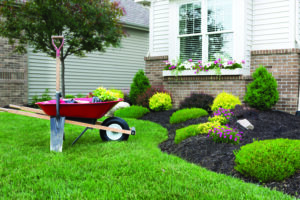Welcome to April! After a winter that didn’t seem to want to end, how special is it to finally say, “Happy spring”?
The spring gardening season is in full swing, so let’s discuss ways to keep your garden healthy. Your time is very valuable and we all want to use whatever time we have to garden, wisely.
The first defense against plant problems is to follow healthy garden practices.
By doing so, there are huge benefits and lower maintenance. 
Remember these suggestions:
• Introduce plant diversity into your garden.
• Try to give native plant cultivars a place in your garden design.
• Buy only healthy, well-rooted plants that are disease and pest resistant.
• Choose plants that thrive in our zone (we are in zone 7). Select plants that will thrive in your soil type, because they are better able to withstand insect attacks and diseases to which the species may be susceptible and they are better able to survive normal droughts.
• Rotate crops of annual flowers, vegetables and herbs.
• Clear out and destroy infested and diseased plants.
• Keep your garden free of weeds that could be carriers of insects and diseases; and
• Finally avoid plants that have been identified as invasive for our area.
I think it is important to follow that old saying, “Give Back to the Earth.”
Compost amends the soil, and should be spread over your vegetable garden or raised beds and apply to a depth of 2 or 3 inches and either dig in or rototill it in.
You can also scratch a handful of compost into the soil around other plants.
I suggest using Leafgro or composted manure, or your homemade compost.
It is also suggested when selecting fertilizers for your gardens that you use organic-based fertilizers.
Doing so allows for a slower, longer feeding.
Using organic types of fertilizers allows for increased microbial activity in the soil.
This refers to the processes and functions carried out by the microorganisms like bacteria and fungi, and aids in decomposition and nutrient cycling, which converts nutrients like nitrogen and phosphorus into energy and food the plant can use.
Microbial activity is also vital for maintaining a healthy ecosystem. Be sure to apply them before you mulch.
One of the most important early spring jobs should be soil testing and if needed, adjusting the pH of your flower and garden beds as well as your lawn.
Ph is the measure of the degree of acidity or alkalinity. A 7.0 reading is considered neutral, any reading lower is considered acidic and any number higher is to be considered alkaline.
Nutrients supporting plant growth cannot dissolve in soil moisture that is very acidic or very alkaline. If the fertilizer cannot dissolve, they will not be able to be taken in by the plant.
Also, beneficial soil bacteria cannot live in the extremes of either condition.
The pH of soil is constantly changing so it is important to regularly test the soil. Be sure to take samples of soil from several areas of the yard or flower or vegetable bed.
Check specific plants’ pH levels as well.
Some plants such as blueberries are very pH-sensitive and will die within two years of planting them if the appropriate pH levels (4.5 to 5.2) are not maintained.
Hydrangea bloom colors are the result of the pH levels of the soil.
If the soil pH is between 4.5 and 5.5, the flowers will be blue, for pink flowers the pH needs to be adjusted to 5.5 to 6.5 and for white 6.5 to 7.0.
Hollies, dogwoods, azaleas, rhododendron and most evergreens prefer acidic soils below 6.5.
Most other plants prefer soil pH closer to neutral (6.5 to 7.0).
To lower pH, we recommend Soil Acidifier by Espoma. To raise pH, use lime.
(Editor’s Note: Ken Morgan is the owner of Robin’s Nest Floral and Garden Center in Easton, Md.)



